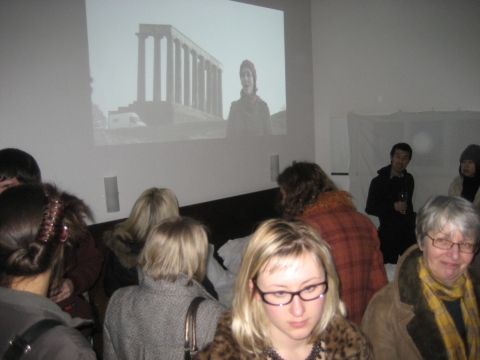- Venue
- Room 113, Point Hotel
- Location
- Scotland
I entered the hotel lobby. Was I looking a little lost or was I just that type? “Hello, are you here for the show?”
“Isn’t this the show?
“No, its upstairs in room 113.”
And with that, the briefest of conversations, I was ushered out of the lobby, into the lift – does it always sound like this or have they amplified the drone? – and into a crowded room of, well, I must admit, people like me.
But let me take a step back and explain the context. I’d been invited to a show by a new art collective called echo, the first in what promises to be ‘a series of events throughout the year, dedicated to diversifying the role of contemporary art in Edinburgh and beyond.’ Hence the non-art context, the Point Hotel, and the title of the show, Starting Point.
So what did I encounter when I entered room 113? Beyond the familiar visitors – rather too many to get the feeling that I was entering a hotel room – I noticed the largest intervention, a wall-based video projection entitled City Break. This showed one of the artists, Tonya McMullan, in winter coat and red beret standing in front of Edinburgh’s mock-Acropolis on Calton Hill. Here, Tonya could be heard singing softly in a high-pitched voice that rose ever higher and higher. There were random ‘events’ in the background – one man, obviously playing to the camera, leant against a pillar and tried to collapse the Acropolis! – but it was unclear whether this was an intended contingency or a distracting by-product. Was the still frame of the video meant to suggest a holiday snapshot, the illusion of which was shattered by the rising sound? Or was the voice somehow commenting on the rising pillars and their obvious folly? Whatever the intention, I enjoyed the image and the sound.
Beneath this video was a double bed with clean white sheets, a white pillow and white duvet. People were laughing so I ventured forward – an intrepid explorer of room 113! – and laid down on the bed to the curious crunch and give – strangely erotic, in fact – of the knäckerbröd (a Swedish oatmeal cracker) that had been placed under the white sheets and which, for some reason, made me think of dry shit, parched earth and infancy. (Indeed, I can still feel the tactile pleasure!)
Arising, and somewhat changed, I stepped into the bathroom. God knows how they charge so much money for these cheap suites, I thought. But then, what to make of the blue cleaning fluid in the bathtub, toilet and basin – a ready-made product no doubt found in a cupboard? And then I noticed it: the intricate craft of a one foot electricity pylon rising out of a crumpled white towel on the bathroom floor. This piece, entitled Out of Disorder, and made by Takahiro Iwasaki, was both delicate and jarring. The pylon itself, made from white polymer thread, was in such marked contrast to the cleaning fluid that it vividly juxtaposed our technological artistry against, what seemed to me to be, a more sinister and destructive environmental side effect.
Out of the bathroom and into the UHT milk cartons: a Tower of Babel-like sculpture stacked precariously on a table and complementing the Acropolis on the other side of the room. Again, to my mind, this played with themes of what we consider to be ‘natural’ and ‘artificial’ and the mythic world that lies between them. Or perhaps the piece reflected the potential boredom of spending a weekend in this hotel room, cut off from the thrum of daily life?
To the left of the Tower – which was entitled Andrew Doolan’s Palace; Doolan being the architect of the Point Hotel – was another video piece. Viewed on a customary hotel TV screen, this piece showed the artist, Paulina Sandberg, apparently asleep in a wardrobe and hugging a white pillow. Placed on the shelves to Paulina’s right were various objects; an apple and a small suitcase among them. The video was grainy and dream-like with only a slow zoom-in for variation. On the other side of the room (although I actually encountered this piece, Stow-away, before I noticed the video) was a wardrobe which, when I opened it, contained a photocopy of Paulina hugging her pillow; this time with the apple and repositioned suitcase alongside various items of clothing. Again, to my mind, this piece had dream-like connotations: an array of archetypal images that the viewer was left to interpret. For me this recalled the Knäckerbröd Bed piece by evoking themes of emergent childhood sexuality. (But perhaps that’s saying too much?)
The final intervention involved a semi-orderly cue of Starting Point participant observers waiting to answer the telephone. When I finally got to the receiver I was greeted by a female voice, that of Jennifer Williams, and, after a failed attempt at conversation – I should have known; the piece was called Listener – I was made privy to a poem about … well, something I can’t translate into prose. But the language was rich, the imagery vivid, and the voice melodious. The only weakness, here, was that there wasn’t enough give and take (unlike the Knäckerbröd), begging the question, why was Listener presented as a ‘live’ performance rather than a pre-recording?
All in all I enjoyed the show; a form of concrete free association (whether intended to be or not). In retrospect I have been able to re-navigate room 113 and re-experience the work. My only real reservation concerns the large number of people in the room for an exhibition lasting only three hours. This detracted from a serious engagement with the work and its context. That said, the numbers also indicate that there is an audience for this sort of collaboration in Edinburgh and I can only look forward to further echoes of this echo.





